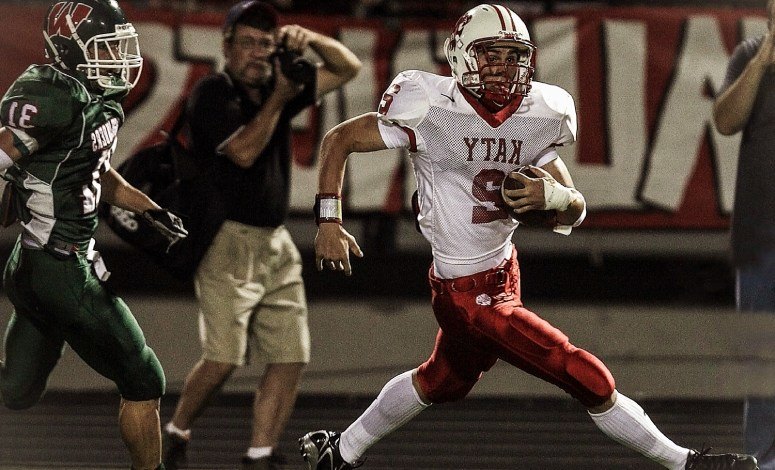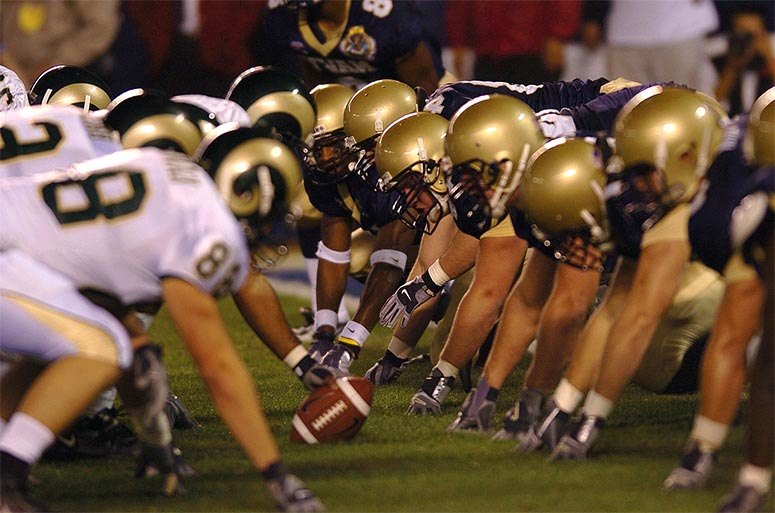Contents
Dreaming of playing in the NFL is a goal for many young athletes, but the path to professional football is filled with challenges and uncertainties.
This article explores the odds of making it to the NFL, examining the factors that influence your chances and providing statistics that paint a clearer picture of this competitive landscape. What are the odds of making it to the NFL?
We’ll dive into this question, discussing the physical and mental requirements needed to succeed, along with practical steps to enhance your prospects.
If the NFL doesn’t pan out, alternative football opportunities are highlighted to keep your passion alive.
What are the odds of making it to the NFL?
The odds of making it to the NFL are incredibly competitive, with countless young athletes vying for a chance to showcase their talent in professional football.
Understanding the statistics surrounding NFL recruitment is crucial, as only a small percentage of high school football players transition to college football, and even fewer advance to the NFL.
Aspiring players must navigate various factors, including athleticism, training, and perseverance, while keeping an eye on the ever-evolving landscape of NFL team needs and recruitment strategies.
Factors that affect the odds
Numerous factors play a significant role in determining an athlete’s odds of making it to the NFL, including their athleticism, training regimen, and the level of competition they face throughout their development.
Evaluating physical fitness metrics such as speed, strength, and agility can provide insights into a player’s potential, while factors like age and commitment to skill development also significantly influence recruitment opportunities.
For instance, younger athletes often have the advantage of showcasing their abilities over a longer period, allowing scouts to assess their growth potential.
Rigorous training programs can further hone an athlete’s skills, making them more appealing to NFL recruiters.
Take the story of a player who, despite starting late, dedicated himself to a structured training program and eventually caught the eye of collegiate scouts.
His relentless work ethic not only transformed his physical capabilities but also demonstrated perseverance, illustrating how a dedicated approach can significantly alter one’s recruitment odds.
Such narratives underscore the vital role of continuous improvement and the importance of resilience in the journey to the NFL.
Statistics on the odds of making it to the NFL
Statistics reveal that the odds of making it to the NFL are daunting, with a success rate of less than 1% for high school players progressing to the professional level.
These statistics underscore the importance of strategic planning in recruitment and highlight the fierce competition among athletes at every stage of their careers.
As prospective athletes transition from high school to collegiate football, the number of participants naturally narrows. Data indicates that of the approximately 1.1 million high school football players, only about 70,000 will compete at the college level.
This shift not only emphasizes the increased talent pool at college programs but also introduces new challenges, such as balancing academics and athletics.
Performance metrics, physically demanding training regimens, and the visibility provided by collegiate competitions play critical roles in shaping an athlete’s prospects.
Ultimately, while many strive for the NFL, each step taken is marked by both achievements and obstacles that define their journey in pursuit of professional football.
What are the requirements to play in the NFL?

To compete at the highest levels of professional football, aspiring players must meet specific requirements set by the NFL, encompassing both physical and mental attributes essential for success.
Physical requirements often include superior athleticism, strength, speed, and agility, while mental requirements demand resilience, football IQ, and the ability to adapt to ever-changing game strategies.
Experience gained through rigorous training and participation at various competitive levels is also critical in preparing future players for the challenges they will face in the NFL.
Physical requirements
Physical requirements for NFL players are rigorous, emphasizing the need for exceptional athleticism, including speed, strength, and agility, to excel on the field.
Performance metrics such as vertical leap, 40-yard dash times, and overall fitness levels play a crucial role in player evaluations and recruitment by NFL teams.
Depending on the position, these physical attributes can vary significantly – for instance, wide receivers prioritize explosive speed and elusiveness to separate from defenders, whereas linemen focus more on raw strength and size to dominate in scrimmage situations.
Measurements such as bench press reps and shuttle run times provide teams with insight into a player’s capabilities, directly influencing draft decisions.
A player’s overall physical conditioning is essential not only for immediate performance but also for sustaining a long, productive career in a league known for its physical demands and the risk of injuries.
Mental requirements
Mental requirements for NFL players are equally as important as physical attributes, encompassing essential skills such as football IQ, adaptability, and resilience under pressure.
Sports psychology plays a pivotal role in enhancing a player’s mental toughness and focus, which are critical during high-stakes game situations.
In the fast-paced and unpredictable environment of an NFL game, players must rapidly analyze opponent strategies, anticipate plays, and make split-second decisions that could sway the outcome in their favor.
This ability to read the game is often referred to as football IQ, a skill that not only involves knowledge of the game but also a keen awareness of dynamic circumstances on the field.
Adaptability is key – players regularly face diverse challenges that require them to adjust their mental strategies on the fly.
To maintain mental fitness, athletes often engage in exercises that promote mindfulness and resilience, while sports psychologists provide essential support to help them develop coping mechanisms for stress and pressure.
By nurturing mental fortitude, players not only enhance their performance but also increase their chances of a successful and prolonged career in this demanding sport.
Experience and training
Experience and training form the foundation for success in the NFL, as players must hone their skills through rigorous training programs and guidance from experienced coaches.
Participation in football camps, combines, and high-level competitions provides invaluable opportunities for player development and exposure to NFL scouts.
These structured environments not only enhance athletic abilities but also instill the importance of discipline and teamwork—key attributes desired by professional teams.
Coaching and mentorship play vital roles in shaping a player’s understanding of the game, helping them to refine their techniques and decision-making skills.
Aspiring athletes often benefit from engaging in game film analysis, allowing them to gain insights into their performance and that of their opponents.
Networking with peers who share similar aspirations can lead to vital connections in the industry, expanding their visibility among NFL teams and increasing their chances of making the roster.
How to increase your chances of making it to the NFL

Increasing your chances of making it to the NFL requires a strategic approach that encompasses dedication, commitment, and a multifaceted training regimen designed to refine your football skills.
Players must actively seek opportunities for growth, engage in networking, and develop teamwork skills that are essential for success at the professional level.
1. Start playing football early
Starting to play football at a young age provides aspiring athletes with a head start in skill development and an understanding of the game, which is crucial for making it to the NFL.
Engaging in youth football programs often lays the groundwork for athletic training, teamwork skills, and a passion for the sport.
These early experiences not only cultivate fundamental skills such as passing, tackling, and ball handling, but also foster an environment where young players can learn the importance of collaboration and communication on the field.
Through participation in structured camps and leagues, they develop a strategic understanding of game dynamics, which is essential for adapting to various playing styles as they advance.
This foundational knowledge not only prepares them for higher levels of competition but also instills a lifelong love for the game, making training enjoyable and motivating.
Investing time in youth football programs can greatly enhance an athlete’s future potential.
2. Join a competitive high school team
Joining a competitive high school football team is a critical step for athletes aspiring to make it to the NFL, as it provides exposure to higher levels of competition and potential recruitment opportunities. Performance metrics and player statistics gathered during high school competitions can significantly influence college scouts and NFL teams.
By participating in intense training sessions and competitive games, young athletes enhance their technical skills, understanding of game strategies, and physical endurance, all crucial for advancing their careers.
Being part of a team fosters essential teamwork capabilities, teaching players how to work effectively with others toward a common goal, which is invaluable on and off the field.
Networking opportunities arise as they interact with coaches, scouts, and other players, opening doors for future prospects. Outstanding performances can catch the attention of recruiters, leading to potential athletic scholarships that provide not only financial assistance but also a pathway to collegiate-level play, setting the stage for a professional career.
3. Attend college and play football
Attending college while playing football offers aspiring NFL players the opportunity to further develop their skills and gain valuable exposure to collegiate-level competition, which is vital for recruitment.
Participating in college football programs can also provide pathways to athletic scholarships, reducing financial barriers to pursue a professional career.
Competing against elite talent on a weekly basis not only hones their athletic abilities but also enables them to learn from coaches with extensive knowledge and experience in the sport.
These college programs often serve as a crucial networking hub, allowing players to connect with professional scouts and agents, elevating their chances of being noticed during the NFL draft.
A well-executed college career can also foster invaluable relationships with teammates and alumni, which may open doors for future opportunities in various aspects of the football world, including mentorship and guidance as they transition into a demanding professional environment.
4. Participate in college football combines and pro days
Participating in college football combines and pro days is a vital opportunity for aspiring NFL players to showcase their skills and receive critical performance evaluations from NFL scouts.
These events allow players to demonstrate their athleticism, speed, and agility, which are key factors in recruitment decisions.
The drills conducted during these events, such as the 40-yard dash, bench press, cone drills, and vertical leap measurements, provide teams with quantifiable metrics to assess the potential of each athlete.
By excelling in these areas, athletes not only enhance their visibility but also significantly influence their draft stock. It’s crucial for these hopefuls to engage in rigorous preparation, focusing on both their physical fitness and mental resilience, to ensure they make the most of this opportunity.
Ultimately, performing well can lead to coveted invitations to off season workouts and, potentially, a spot on an NFL roster.
5. Get noticed by NFL scouts
Getting noticed by NFL scouts is a crucial step in the journey to professional football, requiring athletes to effectively showcase their talent and performance to stand out in a competitive environment.
Utilizing game film, networking with coaches and agents, and excelling in showcases can significantly enhance visibility among scouts.
Athletes should ensure that their game film is not only high quality but also highlights their best plays and overall contributions on the field. This entails compiling footage that captures their skills in various scenarios, demonstrating versatility and adaptability.
Forming connections within the industry can lead to valuable opportunities – engaging with former players, attending coaching clinics, or participating in summer camps can broaden their reach.
Performance during high-stakes games and training camps is paramount, as these settings often provide the ultimate showcase for scouts.
Athletes can bolster their chances by developing a personal brand that resonates with NFL scouts, emphasizing discipline, work ethic, and a commitment to continuous improvement and growth.
What are the alternatives for those who don’t make it to the NFL?

For aspiring football players who don’t make it to the NFL, there are several viable alternatives that still allow them to pursue their passion for the game and maintain a career in football.
Leagues such as the Canadian Football League (CFL) and Arena Football League (AFL) provide competitive opportunities, while roles in coaching and scouting allow athletes to contribute to the sport in different capacities.
1. Canadian Football League (CFL)
The Canadian Football League (CFL) offers an exciting alternative for players who aspire to continue their professional football careers outside of the NFL, providing unique opportunities and a different style of play.
With a growing fan base and competitive teams, the CFL serves as a platform for athletes to showcase their skills and gain valuable experience in professional football.
The league is distinguished by its larger field, three downs instead of four, and a wider array of offensive strategies, which challenges players to adapt quickly.
This distinctive gameplay not only shapes the way the game is played but also influences the recruitment processes, inviting talents who may not have found a spot in the NFL.
For athletes transitioning from the NFL, the CFL presents both a chance to reignite their careers and a unique set of obstacles, including cultural adjustments and different coaching philosophies.
Success in this league can often lead to further opportunities, whether back in the NFL or in other professional circuits globally.
2. Arena Football League (AFL)
The Arena Football League (AFL) represents another alternative for players seeking to continue their careers in professional football, specializing in indoor football with a fast-paced and high-scoring format.
The AFL offers opportunities for athletes to adapt their game strategy and showcase their skills in a unique setting.
This distinct environment not only emphasizes agility and quick decision-making but also enhances the entertainment value for fans.
Unlike traditional outdoor leagues, where the game unfolds across larger fields and more extended play, the compact arenas necessitate a modified style of play, resulting in thrilling scoring opportunities and dynamic gameplay.
Players looking to join the AFL often undergo a rigorous recruitment process, where talent evaluation and adaptability are paramount. The league provides valuable player development programs that help athletes refine their skills.
Successfully navigating the AFL can serve as a springboard for aspiring players, opening doors to further opportunities in other professional football avenues, whether in larger leagues or international competitions.
3. Indoor Football League (IFL)
The Indoor Football League (IFL) provides another viable avenue for athletes looking to maintain their careers in professional football, offering a platform for competition at a high level.
With teams across the United States, the IFL allows players to further develop their skills and gain exposure to scouts and coaches.
This league not only emphasizes on-field performance but also focuses on the competitive landscape that challenges players to push their limits.
For many, the IFL serves as a crucial stepping stone for athletes aspiring to climb up the ranks to more prominent leagues.
Its targeted recruitment strategies, which include collaboration with colleges and regional tryouts, ensure that promising talent gets recognized.
The support systems established in the IFL foster player development through coaching programs and mentorship opportunities, benefiting those committed to enhancing their game while also gaining crucial experience in a competitive environment.
4. Semi-professional football
Semi-professional football leagues offer aspiring athletes a chance to continue playing the sport and enhance their skills, providing valuable opportunities for player development in a competitive environment.
These leagues often emphasize community support and can serve as a springboard for athletes seeking to return to higher levels of professional football.
In these settings, players not only sharpen their technical abilities but also develop crucial soft skills, such as teamwork and leadership, which are essential to succeed in any league.
Engaging with local communities through outreach programs and charity events fosters a strong sense of camaraderie among players and fans, creating a supportive atmosphere.
This community focus not only helps athletes build a solid network but also enhances their visibility, potentially attracting scouts from more prestigious leagues.
Thus, those involved in semi-professional football can effectively leverage their experience to open doors to new opportunities, making this a vital stage in their athletic journeys.
5. Coaching or scouting
Transitioning from a player to a coaching or scouting role offers a fulfilling career alternative for those who don’t make it to the NFL, allowing former athletes to share their knowledge and experience with the next generation.
Coaching provides mentorship opportunities, while scouting enables individuals to evaluate talent and contribute to player recruitment in professional football.
These pathways not only foster personal growth but also help cultivate a deeper understanding of the game, as former players can draw upon their firsthand experiences to guide aspiring athletes.
By leveraging their unique insights, they play a critical role in shaping the skill sets and mindsets of young talents, which in turn enhances overall player development.
Scouting involves identifying potential recruits who may not yet be recognized, thus expanding the talent pool within the sport.
This dynamic interaction between scouting and coaching creates a synergy that strengthens team foundations, ultimately leading to improved performance on the field. Much like evaluating what are the odds of making the NBA, these roles are essential for uncovering and nurturing hidden talent, giving aspiring players a better shot at reaching their full potential.
Find detailed information on NFL career odds in our FAQ section further down this page.
Dive into the intriguing realm of probabilities and rare occurrences. Quench your curiosity by exploring more articles at WhatAreTheOddsOf.NET.



